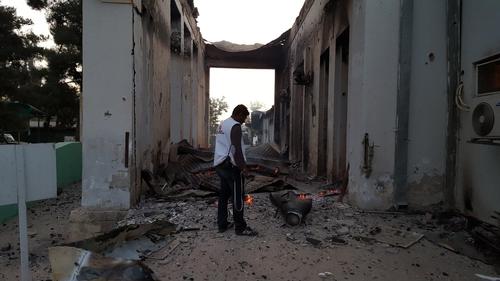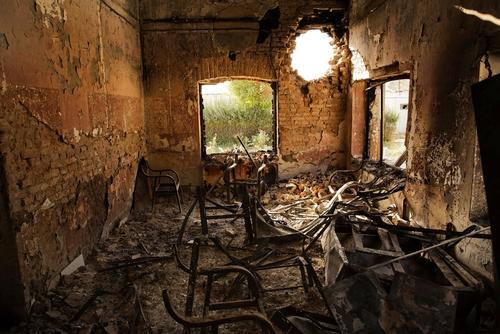First published in MSF's International Activity Report 2015, available to download below.
On 3 October 2015, the MSF trauma centre in Kunduz, Afghanistan, came under targeted and repeated US airstrikes.
The hospital was destroyed and 42 people died, including 24 patients and 14 staff. It had been open since 2011 and provided free, high-quality medical and surgical care to victims of violent and non-violent trauma.
In the year before the attack, staff had treated more 22,000 people and performed almost 6,000 surgical interventions. Below are two edited testimonies from staff who worked there.
Sayed Hamed Hashemy, a surgeon from Afghanistan
Dr Hashemy was operating on a patient when the airstrikes hit the hospital. Two weeks later, he went back to visit the site.
"It was heartbreaking to walk into the hospital compound and to see the building totally destroyed. Everything was burned. The operating theatre where I had been working on the night of the attack had holes in its ceiling and walls. Oxygen bottles and the operating table were lying in pieces and the C-arm [orthopaedic imaging system] was destroyed. In some parts, the hospital no longer had a roof.
Time had frozen: you could sense the moment when everyone had stopped working. It was really strange to see the building like that, and I was sad as I thought about the colleagues who are not with us any more.
On the night of the bombing, I was the on-call surgeon. I was in the operating theatre with an international colleague doing a complicated procedure on a patient when we heard an explosion quite near us. We didn’t move, however, as we didn’t expect a second one. Then, there was another explosion, and the lights went off.
My colleagues were running in the corridor, jumping out of the windows and everyone was looking for a safe place. Everything was falling around us; there was fire, a lot of smoke, loud sounds and shaking from the explosions.
We ran to the sterilisation room but we had stores of gas in there and it didn’t feel safe, so we went back into the corridor to try and reach the basement but we found it was not safe to go back to the operating theatre corridor.
People were scared, colleagues were shouting, there were bits of ceiling, windows and doors everywhere. We finally got out of the building after several minutes of trying to find our way through the chaos. The nearest outlying building was several metres away and we could not risk running there to seek safety.
We jumped down into a structure about two metres below the ground. We stayed there for almost an hour and only decided to get out of our hiding place when we saw fire coming out of the nearby windows in the main building. We ran to the caretaker’s room several metres away from our hiding place and sought shelter there until the explosions finally stopped. I thought: will I see my friends and colleagues alive in the morning?
When the explosions finally stopped we heard the sound of colleagues looking for injured people. I made my way to the morning meeting room and it was really a bad moment. I saw staff crying and hugging each other.
We started to help the wounded. We inserted chest tubes and stopped bleeding wounds. In spite of the limited resources, we did a laparotomy on one of our doctors who was critically wounded but he had already lost a lot of blood and he died shortly afterwards.
The week before the bombing, I worked non-stop and my mother feared for my safety, but I couldn’t stay at home when I was needed at the hospital. As a doctor, I consider it my commitment to help everyone in need.
When I returned to the hospital, I saw it burned, abandoned and no longer full of hope."

Dr Kathleen Thomas, intensive care doctor from Australia
"At 7.35am a dozen international staff from all over the world pile into two MSF Land Cruisers – one for the men, one for the women. We peer through the car windows covered in anti-blast film, for our only glimpse at the hustle and bustle of Kunduz city. I see Mujeeb, the administration officer, walking, and Najib, the data entry officer, riding his bike, both heading to the hospital to start their day’s work.
By 10am the hospital is its usual flurry of activity. I leave the intensive care unit (ICU) to review a patient on the ward. I pass a lab technician bent over a microscope in pathology, walk through the emergency room (ER) and past the operating theatres.
A patient from the wards is being pushed through the doors by a stretcher-bearer, about to undergo specialised trauma surgery by a team of expert international and national surgeons. This is the only facility to offer this type of procedure in all of northern Afghanistan.
Six days before the airstrike
It was about 2am when I was woken by the sounds of intense fighting. Having been in Kunduz for five months of the ‘fighting season’, I had grown accustomed to the sounds of war … but this was different. It was close, heavy and coming from all directions.
I waited for the phone call from the ER announcing the onslaught of patients and the request for help; it took many hours to arrive as the fighting was too heavy for anyone injured to actually get to the hospital.
Then, as the sun rose, the phone call came and so began the longest week of my life.
The first day was chaos – more than 130 patients poured through our doors in only a few hours. Despite the heroic efforts of all the staff, we were completely
overwhelmed.
When I reflect on that day now, what I remember is the smell of blood that permeated through the ER; the touch of desperate people pulling at my clothes to get my attention, begging me to help their injured loved ones; the wailing, despair and anguish of parents of yet another child lethally injured by a stray bullet whom we could not save; my own sense of panic as another and another and another patient was carried in and laid on the floor of the already packed emergency department; and all the while in the background the tut-tut-tut-tut of machine guns and the occasional large boom from explosions that sounded far too close for comfort.
The hospital swelled far beyond our capacity that week. On the wards, all the beds were pushed close together to place additional mattresses on the floor. The demand for intensive care treatment was constant.
We did our best with our limited resources, but helplessly watched numerous patients die who, in normal circumstances, would have survived. Some needed certain rare blood types but no one could get to the hospital to donate; some needed life support from a ventilator, but we had only four machines – not enough to go around; some had been stuck in their homes unable to come to hospital for several days, and by the time they arrived their bodies were overrun by infection.
When the US military’s aircraft attacked our hospital, its first strike was on the ICU. With the exception of one, all the patients in the unit died. The caretakers with the patients died. Dr Osmani died. The ICU nurses, Zia and Strongman Naseer, died. The ICU cleaner, Nasir, died.
I hope with all my heart that the three sedated patients in ICU were deep enough to be unaware of their deaths – but this is unlikely. They were trapped in their beds, engulfed in flames.
One small consolation is that among the chaos, Toorialay, the only ICU nurse to survive, in an act of remarkable bravery, somehow managed to scoop a little girl up from her bed and run out of the building to safety. The same horror that rocked the ICU rocked the rest of the main building.
Our colleagues didn’t die peacefully like in the movies. They died painfully, slowly, some of them screaming out for help that never came, alone and terrified, knowing the extent of their own injuries and aware of their impending death.
Countless staff and patients were injured: limbs blown off, shrapnel through their bodies, burns, and pressure wave injuries to the lungs, eyes and ears. Many of these injuries have left permanent disability.
It was a scene of nightmarish horror that will be forever etched in my mind."
*Some names have been changed
In 2015, 106 aerial bombing and shelling attacks hit 75 MSF hospitals and MSF-supported hospitals.
Of these, 63 were in Syria, five in Yemen, five in Ukraine, one in Afghanistan and one in Sudan.
After the Kunduz trauma centre was targeted in October, over one million people in northeastern Afghanistan were – and remain – deprived of high-quality surgical care. In Yemen, Haydan hospital was destroyed in an airstrike – it was the only remaining operational facility in a district of nearly 200,000 people.
For each publicised attack, dozens of locally-run hospitals are bombed and their destruction goes unreported or fails to generate outrage.
In the Central African Republic in 2015, MSF was forced to partially suspend its activities at Kabo hospital, after an attack by two unidentified gunmen. In South Sudan, the hospital, office and pharmacies in Denthoma 1 displaced person camp in Melut were looted and vandalised, and the MSF compound in Leer was looted twice by armed men. Teams were forced to evacuate, leaving vulnerable people without treatment.
Behind each attack on health facilities are tens of thousands of people who are deprived of access to medical care.



